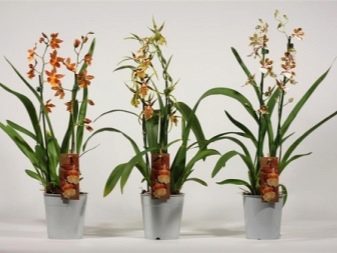Maintenance and care
Optimal conditions of detention
Although the conditions and care of this orchid variety are mainly related to its biological structure, it does not present any particular difficulties even for beginners in exotic floriculture:
- lighting - bright, diffused overhead light. The shape and structure of the leaves require avoiding direct sunlight. With side illumination, the orchid will reach for the light source and, accordingly, "lie down" in its direction. In winter, with a lack of daylight hours, additional lighting with a phytolamp is required. For full development, a sufficient amount of light should not be less than 10 hours;
- temperature regime - moderately uniform from 18 ° to 25 ° С. Cambria also does not need any extremes of night and day temperatures;
- humidity - the optimum humidity for growing at home is considered to be 35-45% humidity. A nearby container with water will fully provide the plant with the necessary moisture. Spraying on the leaf can be applied.
Important! The minimum temperature should not be less than 14 ° С, and the maximum temperature should not exceed 30 ° С.
Watering and feeding
Watering
 The immersion method is considered optimal watering. A flower pot with a plant is immersed in a container of water for half an hour to saturate the bark and loose velamen with moisture. Then they are removed and the excess liquid is allowed to drain.
The immersion method is considered optimal watering. A flower pot with a plant is immersed in a container of water for half an hour to saturate the bark and loose velamen with moisture. Then they are removed and the excess liquid is allowed to drain.
Surface watering is also used. The main thing is to avoid waterlogging of the orchid, in order to avoid decay of the root system. As with most varieties of orchids, it is necessary to adhere to the regime - watering + drying.
The structure of the water should be soft and neutral in acidity. Better to use rain or melt water. Tap water should be well-separated and filtered.
Top dressing
Additional food is introduced no more than 2 times a month during the growth and maturation of pseudobulbs. Fertilizers are used in a lower concentration and only specialized - "For orchids".
They are used for watering and on spilled soil.
Post-flowering care
After flowering, care includes pruning dead stalks and reducing watering. If necessary, it is allowed to spray the substrate with a spray bottle.
When new shoots reach a height of about 3 cm, watering is increased.

Dried orchid stalks are cut off.
Prevention of diseases and pests
Cumbria is a fairly disease-resistant plant. Of course, diseases do happen, but the main ones are associated with the consequences of improper care or an unhealthy orchid acquired.
Therefore, preventive measures are mainly related to the creation of the required conditions and adequate care. Also, a plant bought in a store should be quarantined for a while and treated with drugs from pests or any diseases that may be in it.
Experienced flower growers recommend that preventive treatments with biofungicides be carried out every six months.
Origin and description of the Cumbrian orchid
The Cambria Orchid is not any particular plant species. The name is rather a commercial one, combining hybrid species, in the creation of which three or more genera of the oncidium group were used. Nevertheless, each flower has its own name - for example, the name of the scientist who created this or that hybrid.
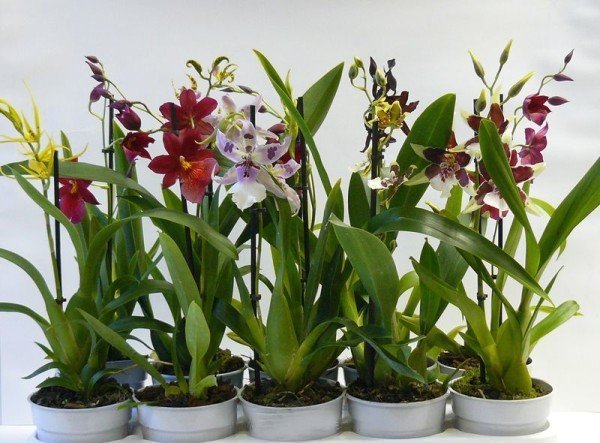
Cumbria orchids amaze with their beauty and variety
A common feature of the hybrids is the sympodial (shoot) type of growth. Cumbria has pseudobulbs of oval, round or ovoid shape. They are also called false bulbs.Their main task is to store nutrients to help the plant survive extreme conditions. The more false bulbs, the healthier the Cumbria and the more luxuriant the flowering.
Each pseudobulb produces up to 3 leaves. They are colored dark green, narrow and long in shape - up to 50 cm. The central vein is pronounced.
Unlike other orchids, which have a strong root system that can hold the plant in place, the roots of Cumbria are very thin and easily vulnerable.
Cambria is capable of throwing out several peduncles at the same time. There are dozens of buds on one flower arrow. They are not revealed all at once. The sizes of flowers, varied in shape, range from 5 to 10 cm. They can be white, yellow, burgundy, cream, pink. Typically, Cumbria bloom several times a year.

Cambria blooms several times a year
Such plants do not occur in nature. They were created exclusively for indoor floriculture. Cumbria are unpretentious and perfectly adapt to their environment. These are perhaps the most undemanding representatives of the Orchid family. Therefore, for beginner flower growers in love with orchids, Cambria is an ideal option.
When buying Cumbria from the store, choose an instance with several pseudobulbs. A plant with one false bulb is usually not viable.
Hybrid views
- Colmanara is a hybrid of Miltonia, Odontoglossum and Oncidium. A long, upright peduncle, which appears at the time of maturation of a young false bulb, is crowned with 5 or 20 flowers. The colors are dominated by yellow and red colors. Duration of flowering - up to 8 weeks. Popular varieties: Wildcat Bobcat, Wildcat.
- Wuilstekeara is a hybrid bred by crossing Odontoglossum, Cohlioda and Miltonia. On long and graceful peduncles, there are from 5 to 20 flowers, mainly in pink, yellow or red colors. The flowering period is from late winter to early summer. Duration - up to 2 months. The species is represented by numerous varieties, including: Linda Isler "Red", Yokara Perfection, Melissa Brianne "Kai, s Choice".
- Burrageara is a complex hydride, the parental forms of which were Miltonia, Kohlioda, Odontoglossum and Oncidium. It is distinguished by its sophistication: several flowers are collected in inflorescences. The color is dominated by a combination of yellow and red tones. Flowering occurs in the winter. The scent of such an orchid resembles the scent of a rose. Varieties: Stefan Isler, Stefan Isler "Living Fire", Nellie Isler "Swiss Beauty".
- Beallara is a complex hybrid obtained by crossing 4 species: Brassia, Miltonia, Odontoglossum and Cochlioda. The flowering period is mid to late summer. The graceful flowers are cream-colored with dark spots or white-pink-purple shades. Of the large number of varieties stand out: Peggy Ruth Carpenter "Morning Joy", Marfitch Howard, s Dream, Tahoma Glacier "Ithan", Patricia Mc Cully.
- Degarmoara is an intergeneric hybrid of Miltonia, Odontoglossum and Brassia. It has flowers of various shapes and colors, up to 10 cm in size. Some of these orchids have a pleasant aroma. The plant blooms year-round. Varieties: Flying High, Winter Wonderland "White Fairy".
Conditions for growing Cumbria orchids at home
Care and maintenance of the Cumbria orchid at home requires strict adherence to all growing conditions, which consist in the correct choice of plant placement, an ideal pot and soil. Only the combination of all conditions can guarantee a beautiful and blooming orchid flower.
Placing the Cumbria orchid indoors
First of all, before deciding to purchase an orchid of the Cambria group, it is important to think about the most suitable place for placing a flower culture.
In this case, special attention should be paid to the issues of lighting and temperature. So, to get a healthy and lush blooming flower, it is best to give preference to window sills on the east or west side.
There is an optimal combination of sunny and shaded periods of the day.
If this is not possible, and the pots are located in the southern parts of the room, then during especially hot periods it is necessary to shade the plants with gauze.
Sometimes in winter, lighting is not enough, since the Cumbria orchid requires daylight hours within 10-12 hours
In this case, you can use phytolamps.
When choosing the optimal location for a Cumbria orchid pot, it is important to consider the temperatures required by this plant. For full-fledged growth and abundant flowering, you need to adhere to the temperature range of 16-21 degrees.
Choosing a pot and soil for Cumbria orchids
When planting and growing this group of orchids, it is important to pay special attention to the selection of soil.
For this plant, you need to take crushed sphagnum, as well as pieces of pine bark. Small pieces of wood ash should be added to this soil mixture so that the bark does not oxidize.
To make the soil light and breathable, it is recommended to add expanded clay, pumice stone or pieces of foam plastic to it.
You can buy a special soil for planting orchids in a garden store, then select the largest pieces from it and put it in pots.
If you are using bark brought from the forest, be sure to boil and dry it to avoid various diseases of the flower.
You also need to carefully consider the choice of a pot or container for the Cumbria orchid.
Unlike other types of orchids, this group prefers to grow in pots that completely block out the sun's rays. In this case, you can take clay or plastic, ceramic and coconut are also suitable.
The size of the pots should be several centimeters larger than the previous one, so that the roots of the Cumbria orchid are freely located along the walls.
Buying Cumbria Orchids in a store
If you have just decided to purchase an orchid of the Cambria group, then it is best to go to a specialized garden store, where a large assortment of high quality varieties of this flower is presented.
It is important to choose the right flower in the store so that after being transported to your home, it can adapt and bloom.
You should not buy a Cumbria orchid with one pseudobulba, since in this case there is a high probability that the plant will not survive and will soon die.
For the full growth of an orchid, at least 2-3 bulbs are required, so you should especially carefully check the surface of the soil for the presence of bulbs.
Also check the upper part of the plant, the leaves and peduncles should be firm and fresh, have a bright and rich shade.
Cambria orchid: home care
Taking care of Cambria at home is much easier than other members of the family (for example, phalaenopsis), but there are certain nuances that should not be neglected.
Pay attention! Likes bright diffused light, it is better if you place it on the east side or on the south, but do not forget to cover the Cambria orchid at noon from the scorching rays of the sun so as not to get a thermal burn.
In winter, it additionally needs a phytolamp or other light sources; exposure to the light should be equal to 10-12 hours every day, or the growth point process will be slowed down.
In terms of temperature, you can maintain a certain degree from 18 -25 ° C, the differences do not affect the nature of flowering. In the evening, keep it cool, but not lower than 14-16 ° C. Humidity no more than 45%
You can use spraying gently on a leaf or place a container of water next to it (fountain or steam humidifier)
Landing description
 To start growing and planting the Cumbria orchid, prepare a ceramic or plastic pot, not one, but many holes. Glass transmits light, which is detrimental to sensitive roots; closed systems must be created for them.At the bottom, it is necessary to lay expanded clay or pieces of pumice, bark to prevent stagnation of excess moisture and aeration of the roots. You can buy Cumbria soil at the pet store or make your own by mixing chunks of charcoal, pine bark, sphagnum, fern roots, or coconut flakes.
To start growing and planting the Cumbria orchid, prepare a ceramic or plastic pot, not one, but many holes. Glass transmits light, which is detrimental to sensitive roots; closed systems must be created for them.At the bottom, it is necessary to lay expanded clay or pieces of pumice, bark to prevent stagnation of excess moisture and aeration of the roots. You can buy Cumbria soil at the pet store or make your own by mixing chunks of charcoal, pine bark, sphagnum, fern roots, or coconut flakes.
Do a transplant only if Cumbria has become cramped, the root system has grown greatly or there are traces of pests, the presence of a disease or excessively wet soil. It is better to postpone the transplant after purchase. By other criteria, try not to bother in vain. Transplant only if the culture has completely bloomed.
When transplanting into a container, first lower the cambria, having previously cleaned it of dead and rotten parts, after drying and processing the sections
Next, carefully spread the roots of the planted orchid and sprinkle with substrate, leaving the pseudobulbs on the surface. To distribute the particles more evenly, tap lightly on the edge of the pot.
The plant should be stable and not topple over.
Tip: You can use a stick made of wood, glass or plastic for tying in the Cumbria substrate. In this form, do not touch or water for about a week, so that the orchid can eventually adapt and restore strength.
Watering and feeding
Under normal conditions, watering should be moderate. In summer once a week, in winter 2 times a week. If the leaves are wrinkled, it means that there is not enough moisture, while yellowness indicates excessive watering, which is why the substrate does not have time to dry out. The method of immersion in water for 1/3 for 5-10 minutes, depending on the season, is quite applicable. Water for these purposes is used soft, settled or filtered or melted.
Top dressing should be carried out after the end of flowering, by immersing the pot in a solution with a small amount of fertilizer. It can be purchased at the store, but diluted well, reducing the concentration, so as not to damage the delicate roots of the plant. Carry out no more than 2 times a month or less often if the orchid has a healthy and well-groomed appearance.
Varieties of Cumbria orchids
Mix
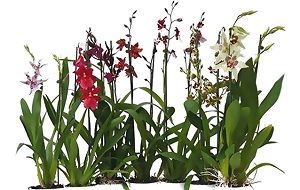 The prefix "mix" only means that the flower is of unnatural origin.
The prefix "mix" only means that the flower is of unnatural origin.
And since Cambria is not a natural phenomenon anyway, the mix is used for commercial purposes.
This means that Cumbria without the prefix mix and Cambria mix are one and the same complex hybrid of orchids, with a large number of varieties.
Beallara Margarita Hill
A complex hybrid with rather high peduncles and numerous flowers, with an unusual coloration of dark red with white lines, strokes and spots.
It blooms almost all year round, each year increasing the number of flowering arrows. The flowers have a light aroma.
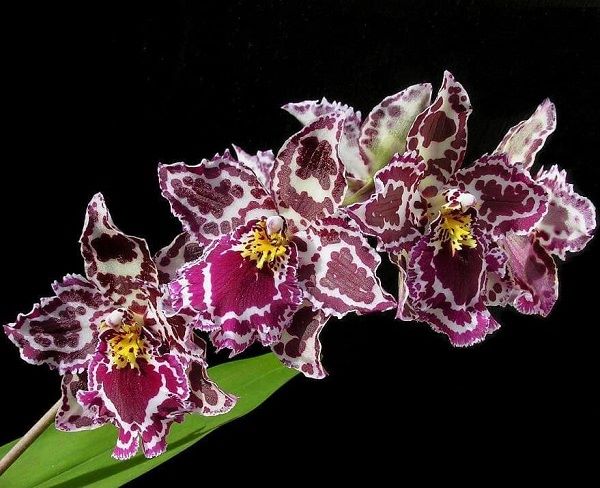
Beallara margarita hill.
Catatante Pacific Sun Sports
Typical for this type of orchid is the crossing of several species. It is characterized by shoot growth, oval pseudobulbs and narrow long leaves with pointed ends.
It stands out for its unusually beautiful color of flowers. Dark red, purple, orange flowers with lines and spots of white color are quite large in size.
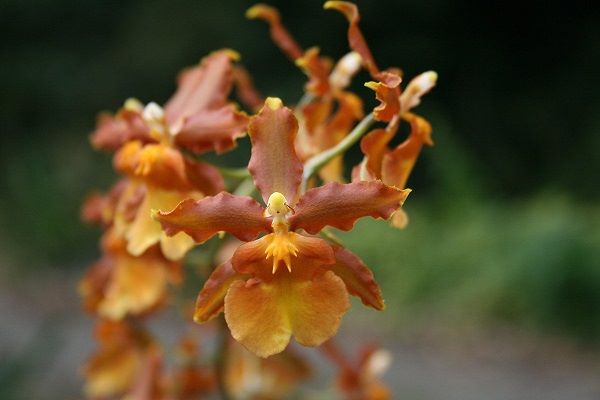
Catatante Pacific Sun Sports.
Colmanara Tropic Jungle
Selection of several species, with high peduncles, oval pseudobulbs and narrow, pointed, rather long leaves with parallel venation.
It usually blooms twice a year with a dozen flowers on each peduncle. The color scheme combines red, white, yellow and brown. The fleshy outgrowth of the white-red lip stands out. It emits a light aroma at certain times.
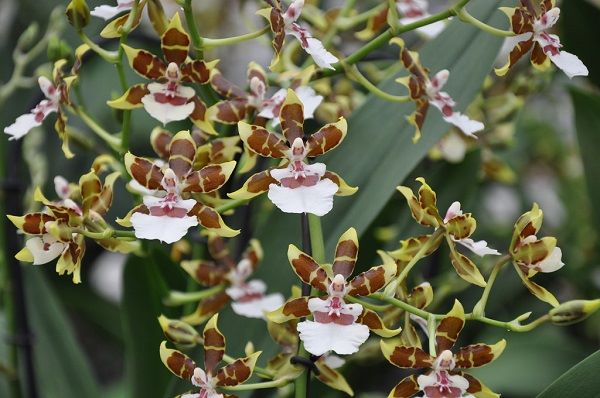
Colmanara Tropic Jungle.
Odontoglossum Stirbik
Although Odontoglossum prefers a cool content, it develops successfully in an apartment environment. Regular growth of bulbs contributes to the emergence of new peduncles, which become more and more with age. The leaves are narrow and long, lanceolate, light green in color.
On tall peduncles, usually from 2 to 7 star-like flowers, with bright stripes, spots of red, white, yellow and burgundy. It emits a light aroma that intensifies at certain times.
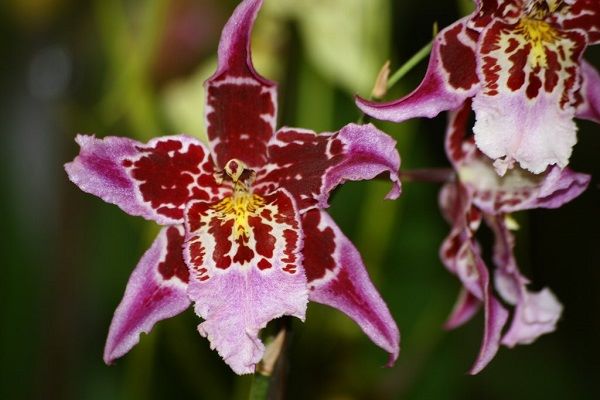
Odontoglossum Stirbik.
The best varieties
Plush - with scarlet petals and sepals. The lip is large, scarlet to the middle, its lower part is snow-white with miniature purple peas. Several bright yellow intermittent thin stripes stretch from the pharynx along the lip.

Nelly Isler - crimson petals, small light specks are scattered at their very tops. The lip is of impressive size, its size exceeds sepals and petals, and is spotty up to the middle. At the throat itself, a square-shaped spot is crossed diagonally crossed by lines of the color of the main background.

Bartley Schwarz - the lip is snow-white, two-lobed, the petals are deep red. The flower exudes a very delicate and pleasant aroma.

Eurostar - star-shaped flowers with long pointed petals of a dull crimson color. Leaves are thin and flexible, break easily.

Anne Claire - on a snow-white background of petals, several velvety-cherry stains. Sepalia are elongated triangular in shape, the lip is rounded with a sunny yellow spot at the very throat.

Favorit - flowers are painted in a burgundy-white spotted pattern. The lip is snow-white in small dark cherry grains, from the center of the throat a sun-yellow tongue of a blazing light slides down it.

Diseases and pests
It is worth starting the reproduction of orchids with the purchase of a mature and healthy plant, which can then give a good offspring. In this case, experts advise buying it from experienced growers. Be sure to carefully examine the plant for signs of disease or insect infestation.
Among the main signs that a flower is sick, one can distinguish:
- black spots or crust;
- white bloom;
- curled or yellow leaves;
- flower petals with holes.
Follow-up care includes disease prevention. Sometimes the grower has to suddenly be faced with the fact that the leaves have acquired brown streaks, dots or spots. Most often this is a sign that the foliage is old and dying off, but sometimes this symptom can be an indicator of a red spider mite infection.
Distorted, uneven growth of new leaves is quite common in some orchid species and is often considered a genetic error that does not harm the plant. Experts claim that this is caused by improper watering. If you first overmoisten the soil, and then leave it dry for a long time, you can achieve a similar result.
Black and watery spots on the pseudobulb may indicate that the plant is kept in too cool and humid conditions. If the plant loses leaves, then it is time for the grower to think about whether he is caring correctly. This applies not only to humidity, but also to compliance with the temperature regime, lighting, and top dressing.
Even a process that is beneficial for an orchid, such as fertilization, can be harmful, especially if a person does not respect the proportions. The composition gets on the foliage, thereby burning it. The amount of fertilizing in the water should be three times less than the standard, since it is applied along with moisture once a week.
The same goes for the lack of flowering. Only if you prune in time, control the temperature and light, you can achieve an increase in the number of flower stalks on the plant. If the plant does not bloom at least once a year, then this is already a sign of a problem. Cambria loves coolness and a lot of light, in accordance with these parameters and the environment needs to be regulated.
Red spots on the leaves, white or light yellow leaves indicate that the plant is receiving too much light.
Shrinking pseudobulbs requires checking the roots. If they are brown or chestnut, then the likely cause is waterlogging, which has damaged them, so the plant cannot take water.To reanimate the roots, you should not water the flower for a while, but you need to spray it regularly with Orchid Mist to reduce moisture loss. Watering can be resumed only when new roots appear. If they are dry, then shrinkage is the result of heavy watering.
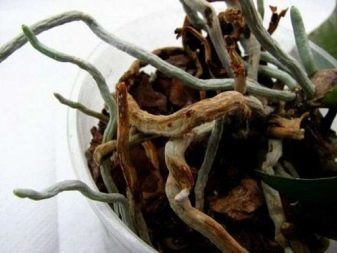

But in addition to problems with the growth and appearance of flowers, the plant breeder often needs to cope with rot, insects. They are very fond of the orchid aphids and scale insects, which are considered quite common even at home. To prevent mass infestation, the plant must be inspected regularly, especially the lower foliage and pseudobulb. Long-term damage from any of these pests can lead to disease and viruses, leading to the eventual death of the orchid.
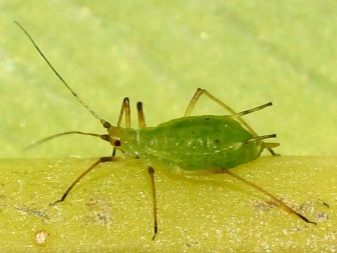

For information on how to properly grow a cambria orchid, see the next video.
Home care
Caring for the Cambria orchid is not difficult. It consists in proper planting, watering, fertilizing and maintaining the required temperature.
Landing
This orchid requires good ventilation of the root system. Good drainage is essential. The roots do not tolerate waterlogged soil and may begin to rot. It is better to choose a ceramic or plastic pot for planting, with drainage holes in the bottom and in the walls.
The size of the pot is selected in such a way that the roots almost completely fill its volume. They are neatly straightened along the walls, without bending inward.
The soil should contain coal and bark, and be sufficiently coarse.
Coal in the soil allows the roots not to dry out for 5-6 days, which is necessary for Cumbria.
Lighting
This plant loves abundant diffused lighting, without direct sunlight. If flowering occurs in the winter, then Cambria needs additional illumination with a special lamp. It is better to place this orchid on the windows of the east, west and north-east direction.
On hot summer days, it must be shaded.
Temperature
The Cambria Orchid does not tolerate heat, sudden changes in temperature and drafts. The optimal mode for it will be indicators from + 16C in winter, to +25 C in summer, but not higher.

Watering
Care must be taken when watering, this plant does not tolerate waterlogging. Watering is necessary when the soil is almost completely dry
The ideal watering option is to immerse the plant pot in boiled, slightly warm water for 20-25 minutes.
Make sure that no water overflows over the top of the pot. Thanks to the drainage holes, the plant will absorb as much water as it needs.
Air humidity
If the temperature in the room is not higher than + 18C, additional humidification is not required. At higher temperatures, humidity should be around 40-50%. You can spray the area around the plant, in hot weather - up to 2 times a day.
Top dressing
They begin to feed Cambria during the growth period, from March to September, about once a month. For this, special fertilizers for orchids are used in low concentration.
It is a good idea to use a weak brew of tea as a fertilizer. With the beginning of flowering, feeding is finished.

The soil
You can use a ready-made earthen mixture for orchids, or you can prepare the soil yourself.
The soil should include: pine or spruce bark, fern roots, coal and moss. At low air humidity, you can add pieces of dry peat, and at high humidity - some pumice crumbs.
Dormant period
As a rule, the Cambria orchid does not have a pronounced dormant period. In winter, when the temperature drops, watering is reduced and feeding is stopped. If the flowering period or the growth of false bulbs occurs in the winter, then the plant is provided with additional lighting, feeding and watering.
Cumbria is not pruned. After flowering, the dried peduncle is removed from the plant.
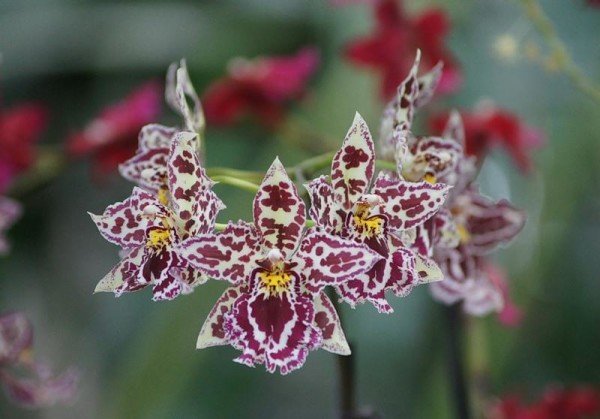
Transfer
The orchid does not tolerate transplanting well, so it should be carried out no more than once every 2 years. You need to focus on false bulbs that do not fit in a pot. The transplant is carried out after the end of flowering or when new roots germinate.
The plant is gently shaken off, if necessary, decayed roots are cut off. Places of cuts are sprinkled with cinnamon or coal and planted in prepared soil.
Reproduction
Cumbria propagates by dividing the bush. When transplanting, the bush is divided into 2-3 parts.
The main thing is that there are at least three false bulbs on each separated part.
Pests and diseases
The most dangerous pests for Cumbria are scale insects, spider mites, aphids and thrips. The affected plant must be isolated and the leaves treated with a concentrated solution of laundry soap or an insecticidal preparation.
Of the possible diseases, Cambria can suffer from bacterial and fungal infections. In this case, the affected leaves are removed and the plant is treated with special medications, and then transplanted into fresh soil.

Humidity
Hybrid varieties of Cumbria can adapt to conditions from 50% to 80%. This is a fairly wide range. When the humidity drops below 50%, it can be corrected with the help of improvised devices:
- Place a wide and shallow container of water next to the orchid. When it evaporates, the humidity rises.
- Spray the area around the plant from a spray bottle with a fine nozzle. The smaller the drops, the better. Ideal when creating a foggy effect.
The need to increase humidity arises in winter when heating devices are in operation. They dry the air. Also, low humidity is typical for sultry summers. In these seasons, you need to especially carefully monitor the barometer readings and take action in time.
Planting cambria
Transplanting cambria is best done after spring flowering, starting in May. The signal to move to a new flower container can be the roots that emerged from the substrate and directed upward, as well as new shoots crawling out of the pot.
Cumbria are grown in ceramic or plastic pots, not necessarily transparent, but with enough holes in the bottom and walls to ensure sufficient aeration of the roots and drainage of irrigation water. During transplantation, a pot is selected with a diameter 5 cm larger than the previous one, and if the division of the bush during transplantation is envisaged, then the same as the old one. The new vessel must be designed to accommodate another 2-3 new growths in the future.
The substrate for growing cambria consists of medium-fine pine bark and charcoal; a good layer of expanded clay drainage is required at the bottom of the flower container. A plant in a new pot is positioned so that the newest shoot is in the center, and the old pseudobulb is near the wall of the vessel
The container is carefully filled with fresh substrate, slowly pushing the pieces of bark between the roots.
The transplanted plant is left alone for one day, so that all small wounds on the roots tighten and dry. The next day, the orchid is soldered and placed on the sill of a shaded window until the roots are firmly fixed in the new substrate, then the pot with the plant is moved to a permanent place of keeping the plant at home.

Peculiarities
The cambria orchid flower makes it special in the fact that there is no need to carry out complicated events for it to show its color. It is grown in large quantities in England because it is considered a wonderful home decoration. Inflorescences begin to form at the base, the maximum number of them is four. As for the palette of colors, this orchid is presented on the market in a wide variety. There are purple and white varieties, dark and light, reds and even orange.
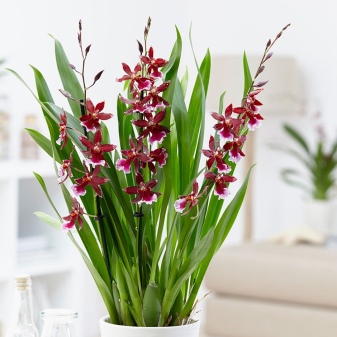
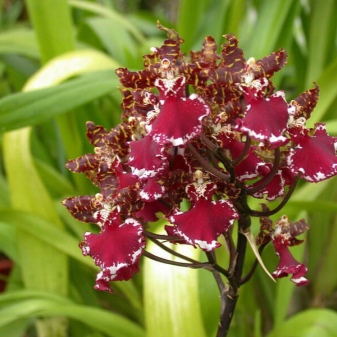
In fact, the term "cambria" means a whole group of orchids, namely hybrids with surprisingly bright colors, sometimes even spotted. All of them are easy to care for, but you need to keep them away from drafts and direct sunlight. This is a great option if the grower is just getting acquainted with the vast world of orchids.
This variety comes mainly from the highlands of the Andes and Central America. Such flowers reach a maximum height of 50 centimeters. The flowers are graceful and delicate, delighting with their beauty for several weeks or even months, depending on the variety. Many have a sophisticated scent, although not strong enough to fill a room.

Sometimes the inflorescences need extra support due to the weight of the flowers. Small supports are used by breeders most often. Already faded flowers are cut off, as over time they begin to rot, spoiling the attractiveness of the orchid. These flowers are not considered poisonous to pets or humans.

